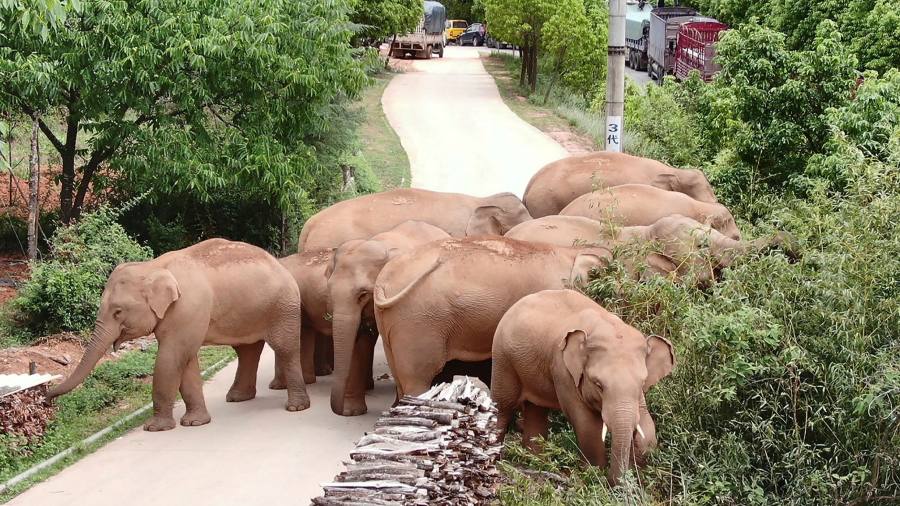A group of wild elephants roaming the villages and towns of southwestern Yunnan province in China has sparked a network of admiration among the admirers and added to the need for the country’s efforts to protect the animals ’natural habitat.
Last spring, 16 elephants from Asia began walking north of the Xishuangbanna nature reserve, a tropical region bordering southern Myanmar and Laos province.

By June, the group, now 15 years old and including the newborn calf, had covered 500 km near the vast capital Kunming in Yunnan. In the process, they became a national obsession.
The Chinese media examines the herd on a daily basis, sharing the latest excerpts from an elephant drone and security camera that roam the tea plantations and the high streets.
A fleet of vehicles and an army of officials have been mobilized to escort the elephants. In one day this month, authorities sent 360 emergency responders and police personnel, 76 police cars and dump trucks, five excavators and nine drones and provided 16 tons of food to the elephants, according to Xinhua State News Agency.
Although some users of the Weibo microblog platform similar to China’s Twitter saw elephants caused by breaking doors in search of food, most relied on photos of sleeping elephant calves gathered around their mother or highlighted the intelligence of creatures.
In a widely circulated video, an elephant goes to the front door of the village house and uses the trunk to turn on the tap so that the herd can drink.
In another, an elephant calf appeared intoxicated by eating fermented grains and a local musician encouraged him to write a song about drunken elephants in Yunnan.
As the herd approached Kunming, Chinese experts hurriedly discussed the exact reasons for the migration and how to deal with the elephants roaming the outskirts of an 8m city.
Zhao Huaidong, former director of the IFAW Asian Elephant Protection project in Xishuangbanna, which educates local people how to handle elephants safely, said the northern migration of the herd is “very unusual” because it did not follow a fixed route.
“Over the past 20 years, the protection of Asian elephants has meant that numbers have increased, but the decline of virgin forests outside protected areas has reduced living space and caused elephants to spread to areas where humans are active,” he said.
Attention to elephant habitats has been renewed as Kunming prepares to host the UN Biodiversity Conference in October. Environmentalists hope China will use the opportunity to protect endangered wildlife and strengthen commitments to increase nature reserves.
The fact that the herd of elephants can move through sad villages is a step forward compared to the past in conserving protected species in China, ? according to ecologists
Asian elephants receive the highest level of protection from Chinese species. Hundreds of years ago, herds would have moved far to what is now central China, but in recent decades the country with about 300 elephants has been limited to Yunnan province.
Local authorities have launched a campaign to keep the animals away from Kunming. They have blocked roads and placed pineapples, sweet grains and other delicacies to keep animals away from crowded areas.
Zhou Jinfeng, director of the China Biodiversity Conservation and Green Development Foundation, warned that trying to repel elephants would be a wrong approach, and could lead to a greater risk of collisions with humans.
“My proposal is that we should not stop their migration completely but establish migration corridors,” he said.
According to Zhou, the tolerance of the villagers and the lack of violence against elephants were noticeable in the past and were a positive sign of the acceptance of protected species. “That’s something that particularly reassured me,” he said.
Additional report by Emma Zhou in Beijing
Source: https://www.wiredprnews.com/the-long-march-of-elephants-necessitates-chinas-conservation-effort/
